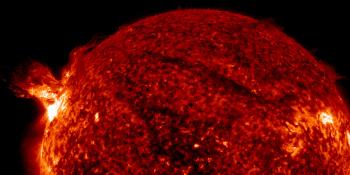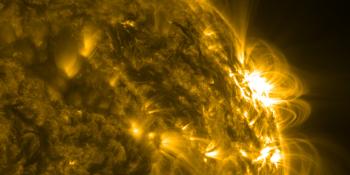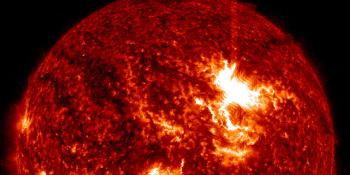Help
On this page you will find an overview of what space weather is all about. For a more detailed explanation with images and other helpful tools we invite you to click on the links that you will find under each paragraph. If you still have a burning question, please leave a post on our forums and we will do our best to help you.
Space Weather Basics
Space weather starts on the Sun. The Sun is so much more than a glowing hot sphere in the middle of our solar system. The Sun is very dynamic and plays a key role throughout the entire Solar System.
The first thing we need to understand is that space is not as empty as it might look. Space is filled with a constant stream composed of highly charged particles (electrons) which come from the Sun. This stream is what we call the solar wind. The magnetic field surrounding our planet makes sure that everybody who lives here is protected from this solar wind. If we wouldn’t have a magnetic field around our planet, Earth would like exactly like Mars: a barren planet without an atmosphere where we human beings wouldn’t be able to survive. While it’s a great thing that we have this magnetic field around our planet to protect us, our magnetic field is not 100% watertight. The solar wind is still able to penetrate our atmosphere near weak spots in an oval shape around the magnetic poles of our planet. The solar wind collides there with oxygen and nitrogen atoms that make up our atmosphere at an altitude mainly between 80 to 600 kilometers. When the solar wind collides with these atoms, the atoms in our atmosphere temporally get a boost of energy. This energy causes the atoms in our atmosphere to temporally release photons, which is a form of energy that we see as light. These atoms emit this light until they calmed down. The light that these atoms emit is the aurora that we see in the night sky.
The solar wind is the first piece of the puzzle that we need to know about to fully understand what space weather is all about. The second piece of the puzzle has to do with the magnetic field of the Sun. This is what we call the interplanetary magnetic field. The interplanetary magnetic field is carried throughout the solar system by the solar wind and its properties change continuously. The interplanetary magnetic field constantly changes both in strength and direction. For aurora we want that the total strength of the interplanetary magnetic field to be as high as possible (indicated with Bt) and that the Z-component (Bz) of the interplanetary magnetic field turns southward. On the graph which you can find on our site you will see a negative value when the Z-component (Bz) of the interplanetary magnetic field turns southward.
But why is it so important for us that the Z-component of the interplanetary magnetic field turns southward? That is actually quite easy to understand if you ever played with bar magnets. If you take two ordinary bar magnets and try to put both of the north (or south-) poles together you will see that the magnets want to move away from each other. They repel each other. If you put the north and the south poles together you will see that they attract each other! The opposite polarities attract each other! Exactly the same principle happens in space where the interplanetary magnetic field and Earth’s magnetic field meet as the magnetic field lines from Earth point from south to north. This is the Z-component of Earth’s magnetic field and this always points to the north. When the Z-component of the interplanetary magnetic field also points north we will see that just like the bar magnets that we have in our homes, the solar wind gets repelled and fails to make a connection with Earth’s magnetic field, making it harder to enter our atmosphere.
Now let’s pretend that the Z-component (Bz) of the interplanetary magnetic field has turned southward. We now know that because the magnetic field of the Earth points northward, the interplanetary magnetic field with a southward Z-component has a much easier time connecting with the magnetic field of our planet. Think of the bar magnets! South and north attract each other! With this connection, it will be much easier for the solar wind to enter out atmosphere. On the graph which you can find on our site we want to see a negative value. This means that the Z-component (Bz) of the interplanetary magnetic field is pointing south.
The solar wind and the interplanetary magnetic field are not constant in their strength, direction, density and speed. These values can be dramatically different from moment to moment. The solar wind here at Earth has a speed of about 300km/s during normal conditions. However, this speed can increase drastically thanks to certain events on the Sun to 1.000km/s or sometimes even more! The density of the solar wind (number of solar wind particles per square centimeter) can also be totally different from moment to moment. Even the interplanetary magnetic field can increase dramatically in strength what in turn can cause a much more dramatic response when it interacts with Earth’s magnetic field. With a high solar wind speed and density and a strong southward directed interplanetary magnetic field we can see that Earth’s magnetic field gets overwhelmed by the solar wind, in turn causing more and more solar wind particles to reach out atmosphere. The aurora becomes brighter and the auroral oval will expand to lower latitudes than normal. When this occurs we speak of a geomagnetic storm. We will get back to this later on because we first need to learn what causes these enhanced space weather conditions. To find the cause of that, we of course need to focus our attention once more on the Sun. We have two distinct phenomena that we need to learn about: coronal holes and coronal mass ejections.
Coronal holes
We start with coronal holes. A coronal hole is an area on the Sun where the Sun’s magnetic field lines stretch out far into space. This causes a hole to form in the corona, our Sun’s outermost layer. These coronal holes are areas on the Sun where solar wind can escape at a higher speed than normal. When such an area faces Earth, the solar wind of such a coronal hole will start to catch up with the normal solar wind which is often considerably slower than the solar wind from a coronal hole. This causes a shock wave to form where the solar wind has a higher density and carries with it a much stronger interplanetary magnetic field as well. When the shock wave has passed we will see that the density and the interplanetary magnetic field strength decreases and the solar speed increases. Coronal holes are often the source of minor to moderate geomagnetic storms here on Earth.
Coronal mass ejections
The most dramatic space weather effects come from so called coronal mass ejections. A coronal mass ejection (or CME for short) is basically a giant cloud of solar plasma drenched with solar magnetic field lines that get expelled by the Sun during dramatic events like solar flares and filament eruption. Later on we will take a look what solar flares and filament eruptions exactly are but it’s wise to remember these two terms as you will often hear them in our analyses!
But let’s take a deeper look at coronal mass ejections. A coronal mass ejection is an enormous cloud of solar wind particles that is often much faster and denser than the ambient solar wind. The interplanetary magnetic field within such a coronal mass ejection is often much stronger as well. The interplanetary magnetic field normally has a total strength (Bt) of about 6 nanoTesla here at Earth but inside a coronal mass ejection this can increase to 40nT or even more! You can imagine that Earth’s magnetic field can respond violently when the strength of the interplanetary magnetic field increases that much!
An important thing that we need to understand is that coronal mass ejections can be launched in any direction. More often than not they will be directed away from Earth. If we are lucky that we do have such a plasma cloud coming towards our planet, then with a bit of luck we can enjoy fantastic auroral displays often at much lower latitudes than normal.
Sunspots, solar flares and filaments
We now know what a coronal mass ejection is but how does the Sun expel these enormous clouds of plasma? For that we of course turn our attention once more towards the Sun. The strongest coronal mass ejection are almost always the result of solar flares. Solar flares are intense explosions on the Sun that occur at complex sunspot regions. A solar flare is so incredibly powerful that we have a hard time imagining their strength. One solar flare equals the power of millions of nuclear bombs. These explosions can break the magnetic field lines near a sunspot region and eject a part of the solar atmosphere (the corona) into space. The plasma that is being ejected and starts its journey through interplanetary space is what we call a coronal mass ejection.
But more about those sunspots because without sunspots, we will not have any solar flares. Sunspots are darker and cooler areas on the solar surface where strong magnetic field lines come up from the interior of the Sun through the solar surface. When these magnetic field lines become entangled with each other and snap, they release a huge amount of energy which we call a solar flare. Sunspots are however not something we can always find on our Sun, the Sun follows a pattern of about 11 years where the Sun goes from pretty much no sunspots to very many sunspots, and back to no sunspots again. This is what we call a solar cycle.
Also so called filament eruptions can launch a coronal mass ejection into space. Filaments are clouds of ionized gases that form above the solar surfaces between areas of opposite magnetic polarities. When a filament becomes unstable, it often collapses and gets reabsorbed by the Sun. Another possibility is that it erupts and manages to escape the gravity of the Sun, the resulting plasma cloud is called… indeed you guessed it… a coronal mass ejection.
Violent solar events like solar flares and filament eruptions sometimes expel large amounts of charged particles into space. The most important particles are protons which can cause damage to satellites and make High Frequency radio communication at polar latitudes hard or even impossible. When these protons exceed a certain threshold we speak of a solar radiation storm.
Aurora
Okay, we now know a lot about space weather. Let’s recap: we know that space weather begins on the Sun where a constant stream of highly charged particles called the solar wind escapes the Sun. Occasionally, we see a dramatic increase in the amount of solar wind that leaves the Sun: coronal hole solar wind streams and coronal mass ejections. The solar wind takes with it the magnetic field of the Sun which we call the interplanetary magnetic field. When the Z-component (Bz) of the interplanetary magnetic field turns southward (negative) then this causes a good connection with Earth’s magnetic field which in turn makes it easier for the solar wind to penetrate our atmosphere. When all the pieces of the puzzle fall in place we will see a dramatic increase in auroral activity which in turns causes the aurora to be visible from lower latitudes than normal. This is what we call a geomagnetic storm.
A geomagnetic storm is thus the result of a coronal hole solar wind stream or a coronal mass ejection arriving at Earth. When we know that there could be a chance of enhanced auroral activity it is time to check out what the magnetometers are telling us. Magnetometers are very sensitive sensors that are located all around the globe and measure the disturbance of the magnetic field around our planet. We can find many graphs on the internet of magnetometers around the world and if we combine all of this data we can make a pretty good guess of how strong a geomagnetic storm is right now and at which latitudes we might be able to see aurora. With the data of these magnetometers, you can give a certain Kp-value to the geomagnetic disturbance. The Kp-index starts at 0 and goes to 9. Geomagnetic storming starts at a Kp of 5, which is a minor geomagnetic storm and goes all the way to Kp9 which would be an extreme geomagnetic storm. The Kp-index is thus a basic way of telling us how big the auroral oval, and how strong the aurora is.
Computers also try to estimate what the Kp-index will be in the near future by using solar wind and IMF data. This is not always 100% reliable but for beginners it is an excellent tool to make a rough prediction if there will be chance for aurora in the coming hour or so. For more detailed help we invite you to read the articles below.
Latest news
Latest forum messages
Support SpaceWeatherLive.com!
A lot of people come to SpaceWeatherLive to follow the Solar activity or if there is a chance to see the aurora, but with more traffic comes higher costs to keep the servers online. If you like SpaceWeatherLive and want to support the project you can choose a subscription for an ad-free site or consider a donation. With your help we can keep SpaceWeatherLive online!
Space weather facts
| Last X-flare | 2025/12/01 | X1.9 |
| Last M-flare | 2025/12/04 | M6.0 |
| Last geomagnetic storm | 2025/12/04 | Kp5 (G1) |
| Spotless days | |
|---|---|
| Last spotless day | 2022/06/08 |
| Monthly mean Sunspot Number | |
|---|---|
| October 2025 | 114.6 -15.2 |
| December 2025 | 186 +71.4 |
| Last 30 days | 106.3 +12.6 |





